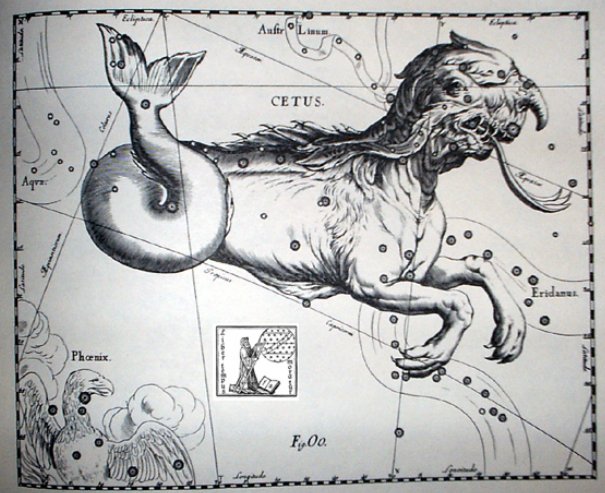47. It is necessary to also include in this part of our investigation the pair Ca1-19--20, although they are at left and combined with other elements in front:
The nose (Menkar) of the Sea Beast came in the day before the blinking Algol, and the front paws of Cetus were there in order to change from swimming in water to moving up on land. The newborn Sun bird (Cb1-18) had his navel string still hanging in front and this was 25 days after Adhil = ξ Andromeda. The star at the train of the garment (Adhil) of the Woman in Chains (Andromeda) marked where the Full Moon was, viz. at the vertical right ascension line from Ana-roto (the star in the middle) and up to the Fox in Ursa Major:
... Proclus informs us that the fox star nibbles continuously at the thong of the yoke which holds together heaven and earth; German folklore adds that when the fox succeeds, the world will come to its end. This fox star is no other than Alcor, the small star g near zeta Ursae Majoris (in India Arundati, the common wife of the Seven Rishis, alpha-eta Ursae ... ... The Arabs in the desert regarded it as a test of penetrating vision; and they were accustomed to oppose 'Suhel' to 'Suha' (Canopus to Alcor) as occupying respectively the highest and lowest posts in the celestial family. So that Vidit Alcor, et non lunam plenum, came to be a proverbial description of one keenly alive to trifles, but dull of apprehension for broad facts ... ... At the beginning of side a on the G tablet was the Chinese 5th station Heart and to make clear what was meant a hint was given in form of the Fox ... Alpheratz, Alpherat, and Sirrah are from the Arabians' Al Surrat al Faras, the Horse's Navel, as this star formerly was associated with Pegasus, whence it was transferred to the Woman's hair; and some one has strangely called it Umbilicus Andromedae. But in all late Arabian astronomy taken from Ptolemy it was described as Al Rās al Mar'ah al Musalsalah, the Head of the Woman in Chains ... A navel is at the midline of the body. At an equinox the Sun is at the midline between the pair of halfyears. And a 'heart' was used at the bottom of an astronomer's plumb line in order to find the correct star positions ...
The breadfruit season was here changing to a season of fishbones, from a season with plenty to eat to a season with scarce food:
... Antares, visible in the morning sky of December-January, came to stand for summer heat; hence the saying, 'Rehua cooks (ripens) all fruit'. The generally accepted version of the Rehua myth, according to Best, is that Rehua had two wives, the stars on either side of Antares. One was Ruhi-te-rangi or Pekehawani, the personification of summer languor (ruhi), the other Whaka-onge-kai, She-who-makes-food-scarce before the new crops can be harvested ... ... Hamiora Pio once spoke as follows to the writer: 'Friend! Let me tell of the offspring of Tangaroa-akiukiu, whose two daughters were Hine-raumati (the Summer Maid - personified form of summer) and Hine-takurua (the Winter Maid - personification of winter), both of whom where taken to wife by the sun ... Now, these women had different homes. Hine-takurua lived with her elder Tangaroa (a sea being - origin and personified form of fish). Her labours were connected with Tangaroa - that is, with fish. Hine-raumati dwelt on land, where she cultivated food products, and attended to the taking of game and forest products, all such things connected with Tane ... ... The Prince (Babylonian Ku), the Messenger of Light, the Proclaimer of Dawn, the Leading One, etc., was Hamal, and on Hawaii the name Ku was used for the origin of the nourishing breadfruit tree (Ulu) - the summer light a-head meant food was a-head ...
... The seasons north of the equator and at the time of Hyadum II - as documented by the constellations - were evidently adopted both on Samoa and on Tahiti:
The breadfruit season uru was over in October when the Sun reached Spica.
|
|||||||||||||||||||||||||||||||||||||||||||||||||||||||||||||||||||||||||||||||||||||||||||||||||||||||||||||||||||||||||||||||||||||||||||||||||||||||||||||||||||||||||||||||||||||||















